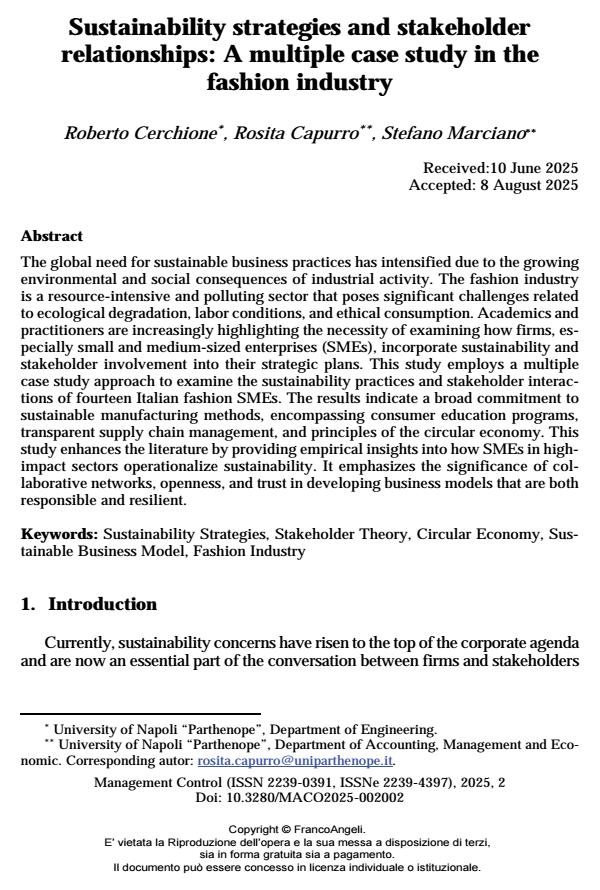Sustainability strategies and stakeholder relationships: A multiple case study in the fashion industry
Titolo Rivista MANAGEMENT CONTROL
Autori/Curatori Roberto Cerchione, Rosita Capurro, Stefano Marciano
Anno di pubblicazione 2025 Fascicolo 2025/2
Lingua Inglese Numero pagine 26 P. 13-38 Dimensione file 240 KB
DOI 10.3280/MACO2025-002002
Il DOI è il codice a barre della proprietà intellettuale: per saperne di più
clicca qui
Qui sotto puoi vedere in anteprima la prima pagina di questo articolo.
Se questo articolo ti interessa, lo puoi acquistare (e scaricare in formato pdf) seguendo le facili indicazioni per acquistare il download credit. Acquista Download Credits per scaricare questo Articolo in formato PDF

FrancoAngeli è membro della Publishers International Linking Association, Inc (PILA)associazione indipendente e non profit per facilitare (attraverso i servizi tecnologici implementati da CrossRef.org) l’accesso degli studiosi ai contenuti digitali nelle pubblicazioni professionali e scientifiche
The global need for sustainable business practices has intensified due to the growing environmental and social consequences of industrial activity. The fashion industry is a resource-intensive and polluting sector that poses significant challenges related to ecological degradation, labor conditions, and ethical consumption. Academics and practitioners are increasingly highlighting the necessity of examining how firms, especially small and medium-sized enterprises (SMEs), incorporate sustainability and stakeholder involvement into their strategic plans. This study employs a multiple case study approach to examine the sustainability practices and stakeholder interactions of fourteen Italian fashion SMEs. The results indicate a broad commitment to sustainable manufacturing methods, encompassing consumer education programs, transparent supply chain management, and principles of the circular economy. This study enhances the literature by providing empirical insights into how SMEs in high-impact sectors operationalize sustainability. It emphasizes the significance of collaborative networks, openness, and trust in developing business models that are both responsible and resilient.
Parole chiave:Sustainability Strategies, Stakeholder Theory, Circular Economy, Sustainable Business Model, Fashion Industry
Roberto Cerchione, Rosita Capurro, Stefano Marciano, Sustainability strategies and stakeholder relationships: A multiple case study in the fashion industry in "MANAGEMENT CONTROL" 2/2025, pp 13-38, DOI: 10.3280/MACO2025-002002